This is a fantastic discovery and story that I’ve kept under wraps for a year and a half now…
For many years we’ve had up on the site (courtesy of Benoit Meulle-Stef) an image of this “fantasy harp guitar” that appeared on the label of Italian (Sicily) maker Carmelo Catania.
Above is an updated image courtesy of the wonderful Fetish Guitars website (which is to cool and retro Italian 6-strings what my site is to harp guitars). They have a wonderful section on Catania that includes much history, including catalogs and many specimens. Their bio page on Carmelo Catania explains that he was born (in Catania, naturally enough) in 1908 and had built his first harp guitar by age 17. At age 18, he went to Naples to work in Calace’s workshop. At age 20, he set up his own shop back in Catania, where he built his second “more elaborate” harp guitar that would become his company’s logo when his business was registered in 1936. So the graphic at left does represent a real instrument! And according to the timeline above, it would have been 1928. Carmelo died in 1970.
The distinctive logo is present on multiple pages of the collected ephemera and seeing it now in more detail and from a different perspective, I realize that the large, dark “tailpiece” shape is actually meant to be a cut-out. In other words, those are strange “lobes” of the body! The 6 neck and 3 sub-bass strings all connect to a small vertical bridge on the middle lobe. I just love this whole graphic, especially the quasi-lyre “soundhole.” It all seemed too much, too stylized, and yet with enough realistic detail that Ben and I imagined that there was a real instrument like this out there somewhere.
But until I just now translated the Fetish Guitars biography, I thought it was just a fantasy.
Better yet, in the Fall of 2011, I was offered this amazing instrument:

Yes, this was it!
Or as close as we were going to come to the fantasy 1928 logo harp guitar.
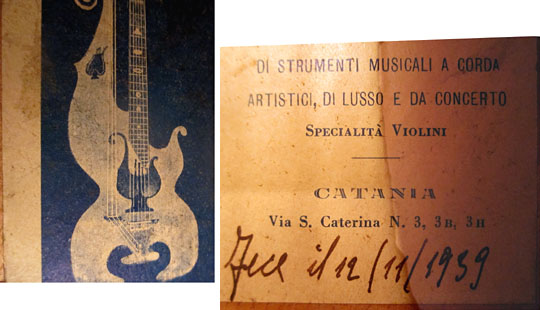
It had the Catania label (dated 12-11-1939), and also a second label of luthier/dealer Salv Spadaro (possibly the distributor).

Unfortunately, it also had a monstrous “repair” to the heads; laughable if it wasn’t so tragic.

What in the world? Were they hoping to rent the headstock out for advertising space?
It was also missing the bridge.
The rest of it though was the real deal, and a very reasonable “practical version” of the more fanciful logo specimen.
While I hemmed and hawed about whether this instrument could be “saved,” it was snapped up by my friend Rainer Krause in Germany. Neither of us knew anyone else was being contacted by the seller. Rainer felt badly and offered it to me at cost, but I knew it was in better hands.
Rainer immediately sent it off to Italian luthier Gabriel Lodi, who recently completed the difficult Iconography-to-Reality challenge!

They mocked up some possible replacement headstock ideas in the style of the logo.

The final result…I think they handled the difficult aesthetic-matching quite admirably.
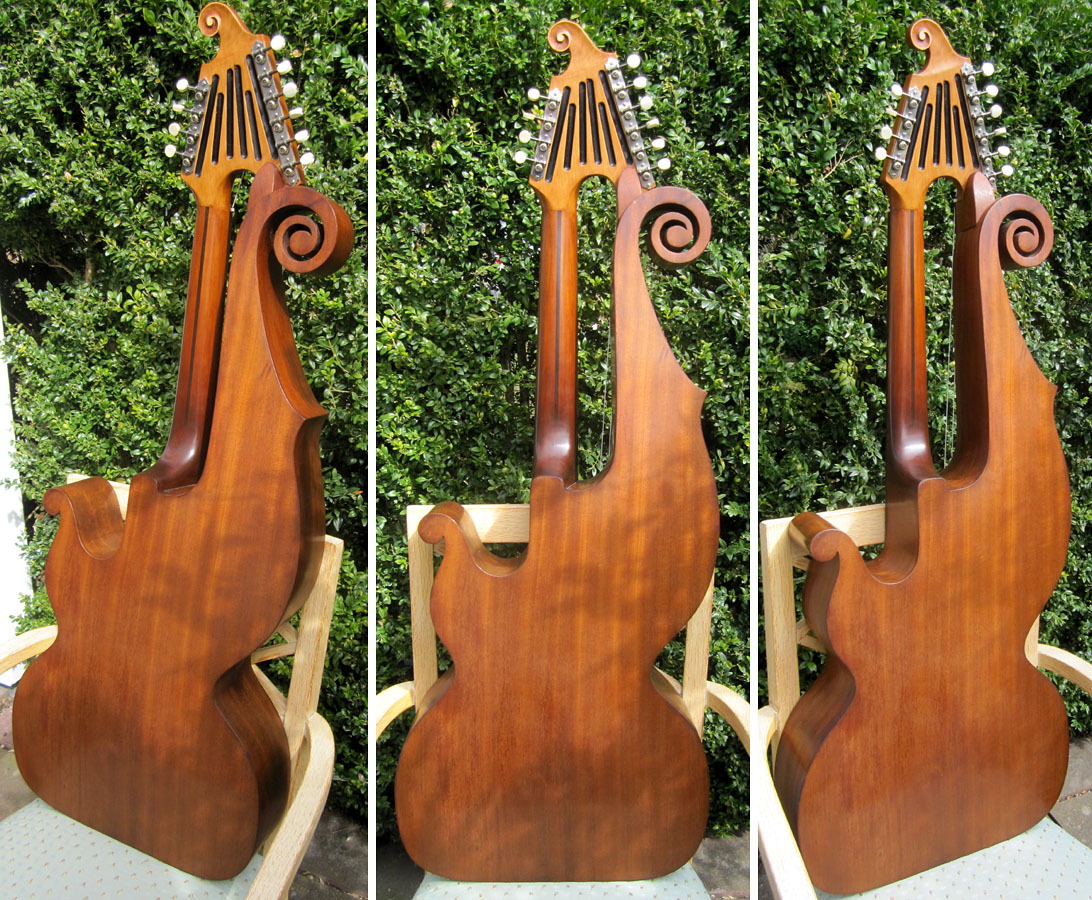
What a great piece of playable furniture!
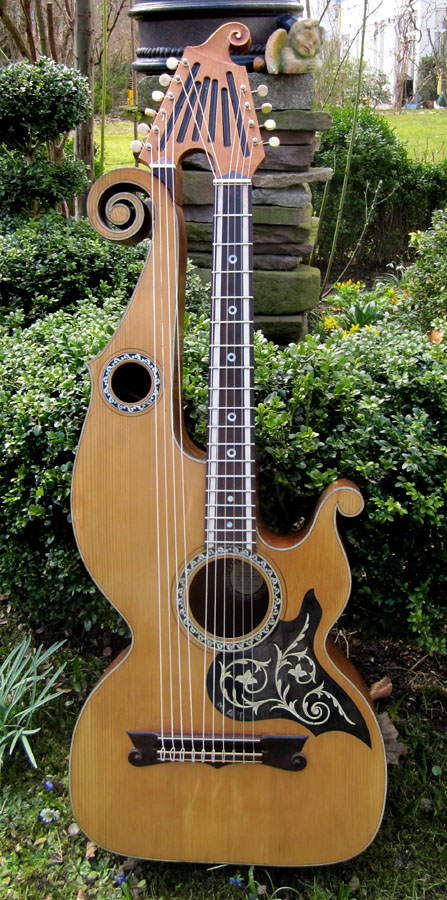
A beautiful tribute to the imaginative Carmelo Catania!
Kudos to Gabriel Lodi, and a big thanks to Rainer Krause for sharing.

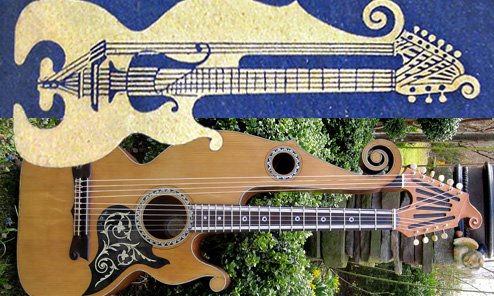

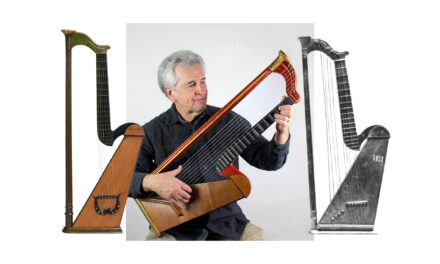
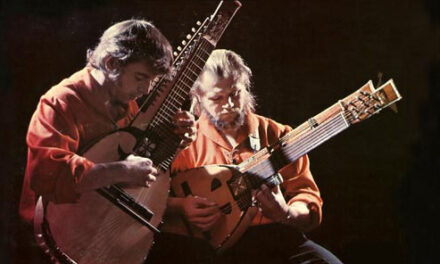
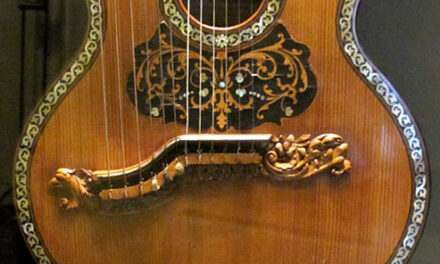

I think it `s a very beautyful and strong sound with this kind of strings but its also possible to play it with metall- strings.`
I`ll try to make a soundexample with a friend in next time. The scale is 27 Inch.
Regards
Rainer Krause
Looks fantastic! And I wonder what it sounds like…………
Hi Gregg …. WOW looks spectacular from the condition I got it in. Hats off to Gabriel Lodi and to Rainer Krause and you Gregg for an orchestrated effort to get this into the right hands!!!! Love the pics and hope someday to hear it played! I’ll keep my eye open for more but that was a rare find!! Peace!!
Wonderful story, Gregg!!
It was on display at Frankfurt Messe…